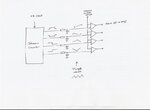T
treez
Guest
Regarding the 2 switch flyback, if you look at the Basso book equation 7-60B on page 615 (post #14 above)…this effectively shows that the voltage available to reset the leakage inductance of the transformer is….
Vin – Vout/[ns/np]
This is a negative value if “Vout/[ns/np]” is bigger than vin.
So what is the mechanism of leakage reset if the 2 switch flyback is continuously connected to an input voltage that is less than Vout/[ns/np]?
Vin – Vout/[ns/np]
This is a negative value if “Vout/[ns/np]” is bigger than vin.
So what is the mechanism of leakage reset if the 2 switch flyback is continuously connected to an input voltage that is less than Vout/[ns/np]?
